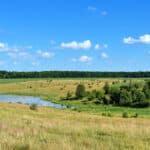This is a question I have received from many landowners looking to cut timber on their own property or perspective buyers looking to purchase land for sale with a timber investment component. I tell people who are looking to purchase property with the intent to cut later in the future, to buy at least 40 TIMBERED acres. The reason I emphasize “TIMBERED” acres is because some properties may be 40 acres, but they have a pond, a large SMZ (streamside management zone), a house, a pasture, etc. Therefore, it is not 40 “TIMBERED” acres. The rationale behind this is that logging is trending to the higher production type of tracts. In other words, a tract of timber needs to have enough volume on it to justify the logging company to be able to cut it.
For example, I, as well as every other forester in the procurement or consulting business have gotten that phone call from a landowner that wants 5-20 acres cut. While this is not to say that it couldn’t be cut, it is harder to move a logger to cut such a small tract by itself. In a situation like this, the best option for getting it cut is when there is a logging operation being done very close to your property. Sometimes they can be so close they can drive the equipment to your job without having to load it on a low-boy trailer. Every time a logging crew moves, it is costing them money. Not only in overhead, salaries, and fuel, but also for the time in which they are not in the working in the woods, cutting, skidding and hauling wood.
Gone are the days of logging with mules and horses. My great grandfather was one of these loggers. He logged for nearly all his adult life in east central Alabama. Depending on the type of wood, 5-20 acres would take several weeks or months to harvest. Today, with logging equipment being highly mechanized with the latest technology, newer machines allow a crew to cut 20 acres in just 2-3 days. Along with this high mechanization and technology comes cost. With a good portion of crews having to finance their equipment, they must maintain a certain amount of production each week to cover their costs.
Of course, as with any “Rules of Thumb,” there are always exceptions. If you had 20 acres to cut, is there a good chance that someone who wasn’t cutting close by would come cut it? Sure. I’ve seen 20 acre tracts that have more volume on them than a 50 acre parcel. However, when you do decide to harvest some timber on your property, make it as attractive as possible when marketing it to ensure you get the best possible price. Having a tract with close to 40 acres of timber or more would be a big step toward doing that.
If you are looking to purchase a tract of land with a timberland component that you want to manage for a future harvest, talk to an experienced and knowledgeable Land Professional and/or a Registered Forester that can help you find that type of property you are looking for.
If you’re in search of timberland for sale for the purpose of managing a future harvest, talk to an experienced and knowledgeable Land Professional and/or a Registered Forester that can help you find that type of property you are looking for.
This content may not be used or reproduced in any manner whatsoever, in part or in whole, without written permission of LANDTHINK. Use of this content without permission is a violation of federal copyright law. The articles, posts, comments, opinions and information provided by LANDTHINK are for informational and research purposes only and DOES NOT substitute or coincide with the advice of an attorney, accountant, real estate broker or any other licensed real estate professional. LANDTHINK strongly advises visitors and readers to seek their own professional guidance and advice related to buying, investing in or selling real estate.










Your article is a great one. I have gathered a new knowledge for my real estate investing business. Thanks for sharing.
There are available Loggers who still use horses and mules to cut timber. Not everyone, wants the big modern log companies, to tear up their land. Selective harvesting, also leaves the younger trees from damage from machinery. Not against these companies but to say yesterday method for smaller tree plots not in existence isn’t true. Research available Mother Earth, and other web sites.
Brian, Do you have any suggestions for me? I’m interested in purchasing a commercial property that once had a building that has since been torn down. There is quite a bit of timber there, some younger than others. I’m really just interested in clearing the land for building but I didn’t want to overlook the value of what’s there to help defray the cost of clearing. If I hired someone to do the cutting, could I possibly sell the cut timber in some form?